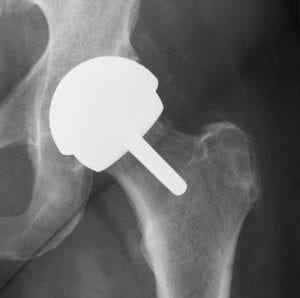 Metal-on-metal hip implant concerns have gotten the FDA’s attention. The agency announced in December 2017 that metal-on-metal (MoM) hip implants carry unique risks, in addition to the general risks of all hip implants.
Metal-on-metal hip implant concerns have gotten the FDA’s attention. The agency announced in December 2017 that metal-on-metal (MoM) hip implants carry unique risks, in addition to the general risks of all hip implants.The metal ball and metal cup in MoM hip implants slide against each other while an implantee is walking, sitting, or running. When metal from the two parts rubs together, tiny particles can wear off of the ball and cup, moving around or between them.
Metal Poisoning
The FDA notes that wear and corrosion at the connection between the metal ball and taper of the stem may also occur. Some of the metal ions – such as cobalt and chromium – from the metal implant or from the metal particles will enter the bloodstream, according to the FDA.
Related: Hip Implant Lawsuit
Surgical Cautions
To optimize the way in which the ball and socket rub against each other, the FDA says orthopaedic surgeons take several precautions before and during hip replacement surgery. The idea is to produce and release as few metal particles as possible, but therein lies the problem. There is simply no way to fully avoid the production and release of some metal particles.
The agency acknowledges that different people will react to the released metal particles in different ways. It also admits that it is not possible to predict who will have a reaction, what type of reaction might occur, when it will occur, or how severe it will be.
Adverse Local Tissue Reaction – ALTR
Metal particles around some implants can eventually damage bone and/or tissue surrounding the implant and joint. An “adverse local tissue reaction (ALTR)” or an “adverse reaction to metal debris (ARMD)” can cause soft tissue damage. Such damage may lead to pain, implant loosening, device failure, and replacement surgery. The agency says, “Patients with a progressing ALTR may be considered for earlier revision to prevent extensive damage to bone, muscle and nerves.”
Safety Alerts for MoM Hip Implants
• April 2010: The United Kingdom’s Medicines and Healthcare products Regulatory Agency (MHRA) issued a medical device alert that included specific follow-up recommendations for patients with MoM hip replacements. Recommendations included blood tests and imaging for patients with painful MoM hip implants.
• February 2012: MHRA published a medical device alert, updating it in June 2012 with advice on managing and monitoring MoM hip implant patients.
• May 2012: Health Canada issued a public health communication to orthopaedic surgeons and patients over MoM hip implants.
• Sept. 2012: Australia’s Therapeutic Goods Administration published safety information for healthcare professionals on MoM hips.
Metal-on-Metal Hip Implant Concerns
FDA adds that reports in orthopaedic literature, data from international orthopaedic implant registries and presentations from professional/scientific meetings have increasingly noted complications and potential problems of early MoM hip system failures. Much of the available data comes from countries outside the U.S. It may not be directly applicable to the experience in the U.S. Some of the devices available outside the U.S. are not marketed in the U.S.; so international regulatory agency recommendations may not apply to U.S. patients with MoM hips.
The FDA recommends that MoM hip implant patients who develop any symptoms promptly make an appointment with their orthopaedic surgeons. Besides a physical exam, the surgeon may consider several tests to evaluate the symptoms. Tests may include:
• Needling fluid from around the joint (joint aspiration)
• Soft tissue imaging
• Blood tests that measure metal ion levels in the blood
Patients who receive MoM hip implants should also pay close attention to changes in their general health including new or worsening symptoms outside their hip. If they are referred to a doctor to evaluate new conditions, they should let their physician know they have a MoM hip implant. Some case reports and articles in the medical literature suggest MoM hip implant patients may see certain symptoms or illnesses elsewhere in the body (systemic reactions). These include:
• General hypersensitivity reaction (skin rash)
• Cardiomyopathy
• Neurological changes including sensory changes (auditory or visual impairments)
• Psychological status change (including depression or cognitive impairment)
• Renal function impairment
• Thyroid dysfunction (including neck discomfort, fatigue, weight gain or feeling cold
FDA says that unless Mom hip implant patients have signs described above, there is not sufficient evidence to support the routine need for checking metal ion levels in the blood or soft tissue. But the FDA is “recommending that asymptomatic patients with MoM hip implants continue to follow-up with their orthopaedic surgeon every 1 to 2 years to monitor for early signs of change in hip status.”
Related
- DePuy Hip Replacement Lawyer
- Biomet Hip Lawsuit
- Hip Implant Verdict: $1 Billion
- DePuy Hip Verdict: $498 Million

by Matthews & Associates




